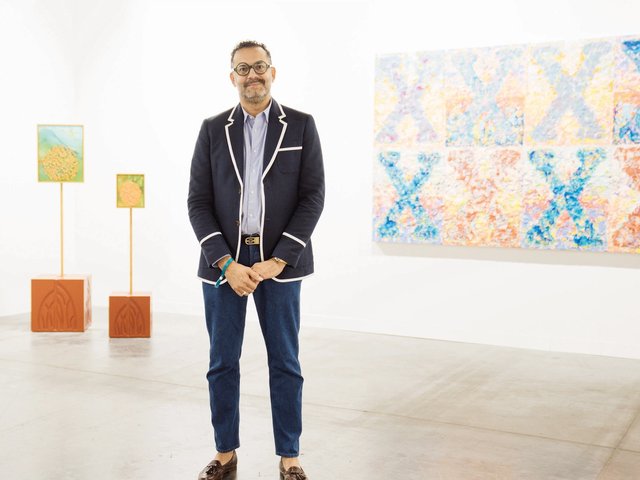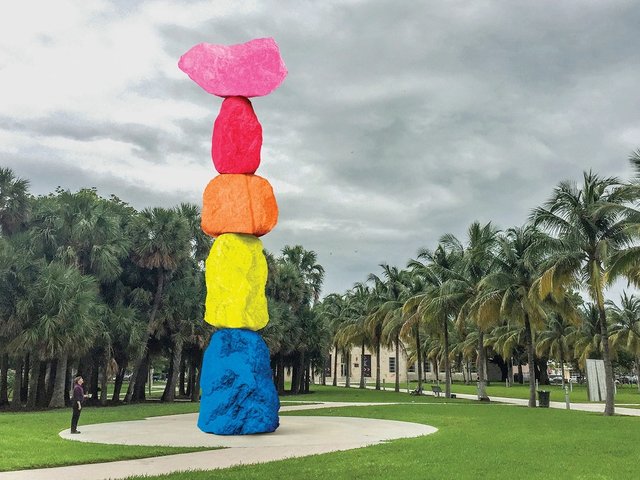Art Basel Miami Beach celebrates its 10th edition this year, with its most “grown up” public programme yet. Following the demise of the much loved, but commercially impractical, shipping-containers-as-art-spaces on the beach, the organisers have now also dropped the DJ-inspired-hipster-hangout Oceanfront space of last year, and the annual one-off evening “band on the beach” in favour of a programme that is all about visual art.
Marc Spiegler, Art Basel’s co-director with Annette Schönholzer, says that, since they took over from Sam Keller (fair director 2000-07, who inaugurated the Art Basel Miami Beach edition), they “have been going away from the crossover strategy—of building bridges to other creative fields—really to focus on the art world”. Not, he adds quickly, because he doesn’t think that bridge-building is worthwhile, “but at one level it’s already happening”. And of course, on another, it is the art experience that Art Basel offers the city that is unique.
This year’s programme, which is intended to be as public-facing as possible, involves two architecturally important neighbours of the (rather less than lovely) Miami Beach Convention Center, which houses the modern and contemporary art fair. The Frank Gehry-designed New World Center, the home of the New World Symphony Orchestra, which opened earlier this year, will host a much higher profile Art Video programme, screened on the outside of the building and free to all. Organised by London’s Artprojx, the programme will include six themed presentations based on words such as “music and dance”, “landscape” and “painterly”. Highlights will be on show in the fair in specially designed “pods”—but to get the best view, visitors and the general public head to the concert hall, where the screen and refreshments will be sited.
Meanwhile, the Bass Museum of Art, one of Miami’s historic public buildings designed by Russell Pancoast in 1930 in the archetypal Miami Art Deco style, with a 2002 addition by the Japanese architect Arata Isozaki, will be the setting for a new sculpture “park”. The museum, originally the city’s library and arts centre, is situated at the end of Collins Park, donated by Miami Beach’s founder, John Collins, in the 1920s. Collins Park runs from the museum to the oceanfront and here will be shown around 20 pieces of public sculpture, and performances by Los Angeles-based artist Glenn Kaino and New Yorker Jen DeNike will be staged there as well. The selection has been made by Christine Kim, associate curator of contemporary art at the Los Angeles County of Museum of Art (and a co-founder of LA’s non-profit public art organisation, Land), in collaboration with the Bass. Banks Violette’s first outdoor sculpture (a partly crushed black barrier, shown earlier this year in woodland in Tilburg, the Netherlands) will get its first outing in the US, while Rachel Feinstein will show Gargantua, a work based on the illustrations of Rabelais’s work of that name by the 19th-century illustrator Gustave Doré. Meanwhile, the artist, activist and urban planner Theaster Gates will present a series of sculptures based on the Civil Rights movement, as well as staging a performance with the Black Monks, entitled A Sermon on Art History.
The aim is to make it easier for the Miami public, as well as fairgoers, to take part. “We’ve always had public art placed in sites across the city, but I’m not sure how easy it was for people to find them,” says Schönholzer. “We’ve never lost faith with the idea, but it seemed a good idea to focus everything in one place and the Bass Museum made sense.” Spiegler agrees: “It’s one thing to have a sort of ‘treasure hunt’ around a medieval city like Basel [Art Basel’s home base], but there’s so much going on here and it’s such a big city, it’s easy for things to get ‘lost’.”
Of course, as one of the highlight talks of Art Conversations, featuring leading Miami collectors, will no doubt point out, there was art in Miami before Art Basel Miami Beach; the presence of a collector base and Miami’s popularity with Latin Americans were two of the determining factors in the creation of the fair. But with ten years in which Art Basel Miami Beach has coincided with the opening of private museums, the construction the Arsht Center for the Performing Arts and the groundbreaking for the Herzog and de Meuron-designed Miami Art Museum, there’s no doubt that this year there is something for the city, and fair, to celebrate.
Art Galleries
Visitors to last year’s Art Basel Miami Beach, which largely solved the layout problems introduced in 2009, will notice relatively few significant changes to the fair. In the main galleries section of just over 200, there are around 30 new or returning galleries, and 24 drop-outs (see box below), and, although there is a growing emphasis on US and Latin American galleries, the European contingent remains strong. Most notable features include the increase in the number of galleries mounting special “Art Kabinetts” (30) and the more selective approach to Art Nova, focusing on new work by two or three artists, with 42 down from a high of 64 in 2009. Art Kabinett, with its mini “curated” shows within stands, usually appeals most to those with a bent for art history and theory, while Art Positions, this year with a strong Latin American feel, shows a selection of younger galleries and less well known artists than the big ticket Art Galleries fare.
Originally appeared in The Art Newspaper as 'Art Basel Miami Beach makes the art its principal priority'



